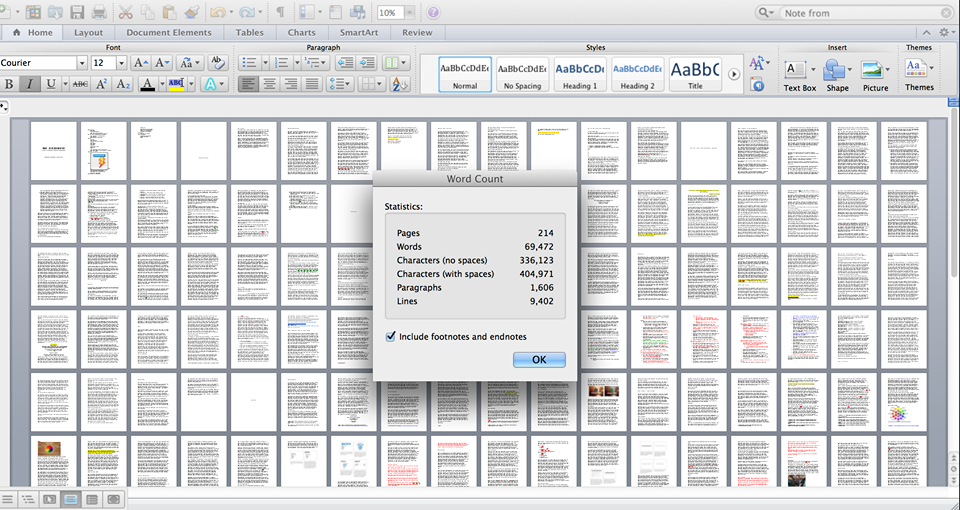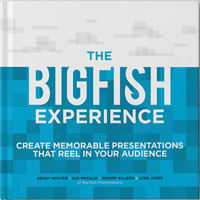4 lessons we learned from writing our own book.
Our goal has always been to help presenters. Our blogs, SlideShares and daily work is all about much more than gaining a following and making money. It’s about fixing something we find inherently wrong with presentations.
This is why we help companies, share our thoughts and provide tips and walkthroughs on how to combat the dull stigma of presentations. Our motto is “We turn presentations into experiences,” but it’s actually more along the lines of “We want to help you turn presentations into experiences.”
This has always been a value we stood by and strive for, so we were in awe when a major publishing company approached us to write our own book. They saw it as an opportunity to capture our essence and unique approach to presentations, and we saw it as another way to help people like you.
However, a book is much more difficult than a blog or SlideShare. Four of us were working on the book (Kenny, Gus, Rob and Luke), and even with our combined efforts we still hit more pitfalls, bumps and brick walls than we’d like to admit.
So, what exactly did we all learn from this?

Kenny: Define your strengths and weaknesses in the creative process.
Running a company while writing a book is not an easy task. While I thought I could balance out time during the day and night, it created an immense amount of stress on myself. Sleep was rare, chapters took a long time to write and it was tougher to onboard new clients. Everything began to suffer and I desperately needed to find a system that worked.
I decided to do some self-reflecting and be brutally honest with myself on my strengths and weaknesses when it came to my creativity. I soon learned my main flaw was that I was a perfectionist in writing and that the reason why my drafts were so long was because I always wanted them to be perfect. This was terribly inefficient for our deadline. I knew what I wanted to say but I didn’t know how to say it. Fixing this, I decided to funnel all my thoughts and bullet points for every topic to our trusted writers (Luke Jones and Robert Killeen).
In weekly meetings, they fleshed out my points into documents we would review at the end of the week. I would then read over the content, fact-check and give any additional input. While everyone has a different creative process, I believe it just takes some brutal honesty to not do everything on your own and admit when you need help. Learning my strengths and weaknesses when developing my own writing process allowed me to find solutions to ensure better efficiency not only for the book, but also for running a business.
Gus: Pace yourself.
The thing that made it the easiest on me during my writing process was making sure I gave myself the right amount of time to flesh out my ideas. I started off making goals such as completing three or four sections a week. These goals were either not met or I undershot how much I could do.
Depending on the material that a writer is writing about, this can change how long each chapter or section will be in length. So instead of trying to complete a set amount of sections a week, I just set up a schedule for myself with groups of chapters I knew I could finish well in the time that I gave myself.
I didn’t want the final product to suffer just so I could knock off things from my to-do list. I really focused on trying to make every section I wrote the best that it could be by rewriting and rewriting. Instead of rushing through the process, I paced myself. I took my time. It was this that allowed me to write material I was confident with and proud of.
Rob: Don’t legitimize your own style.
When we first started writing the book, quotes and references covered each page. We did this not only to try and appeal to every audience, but also to prove that our way wasn’t the wrong way; however, this isn’t what our publisher wanted. They wanted us to write about how we did our work, and not why we did it. This was actually a pivotal moment for me, because my biggest struggle in writing my sections was explaining why I do certain things.
I focused too much on trying to prove to readers that my writing style was the correct one. I couldn’t justify it, but that was because the way I write for Big Fish is neither right nor wrong; it’s simply… different. It’s my own style that makes me a good writer and allows me to contribute my part in making Big Fish unique. It’s what separates me from every other copywriter, but also what helps separate Big Fish from every other company.
I eventually realized this is true with everyone. Whether you’re a designer, chef, presenter, CEO, artist and so on, you have your own way of doing things – your own style and approach. This is what prevents you from being a copy of someone else and makes your work unique. In the end, I realized it was my own style that legitimized my work.
Luke: Structure should be perfected before anything is done.
Going through this process, we ended up wasting a lot of time adding new sections and removing redundancies. We repeated ourselves, made last-minute additions and kept moving sections into different chapters. It all added up to become a hassle that took up more time than it was worth.
This happened because we failed to look at the big picture and really outline everything. We rushed into each section eager to explain our thought process and approach, eventually realizing there was no real organization to what, why and how we did what we did. We never had to outline ourselves in the way the book forced us to, so not taking our time and planning ahead ended up becoming a huge time sink that could’ve easily been avoided.
When we took a step back from trying to explain ourselves we realized that, just like anything else, there needed to be structure to our execution. Building a house, buying a car, planning a vacation… Think about it: Every important action and decision requires an intense amount of analysis and planning before a single step is taken. This book was no different.
Everything we walked away with from writing this book was only achieved through tremendous effort paired with constant trial and error. We believe the lessons we learned have made us better at what we do and much more prepared to write another book.
We wanted to share our experiences in hopes that you can also take something away from the lessons we learned and mistakes we made, applying them to yourself and your work. After all, the whole point of the book is to help people like you. So, as always, thanks for reading.
Like what you’ve just read?
Get more tips and advice by subscribing to our blog,
liking us on Facebook and following us on Twitter.




Share your opinion.